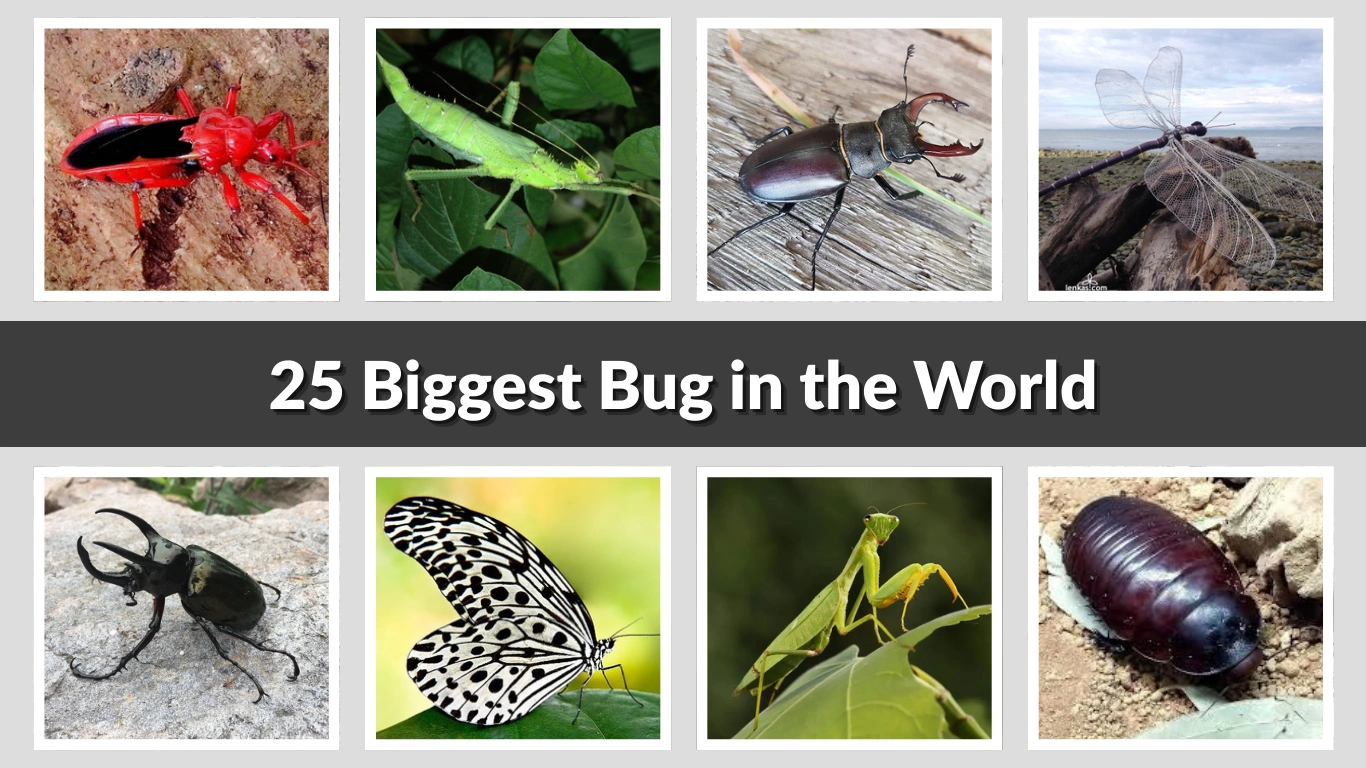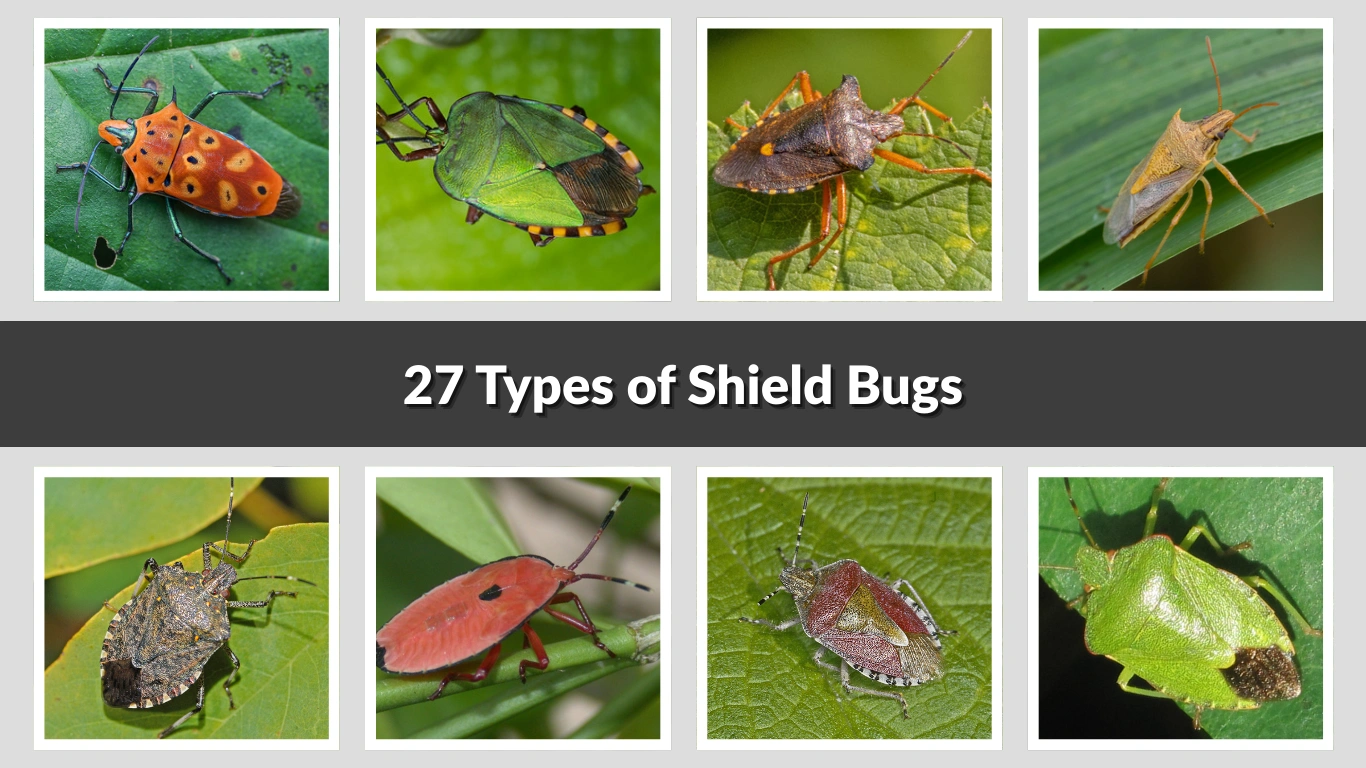Beetles are one of the most diverse groups of insects, with over 350,000 known species worldwide. They play essential roles in ecosystems, from pollination to breaking down decaying material. Some beetles, like ladybugs, are beneficial predators, while others, such as bark beetles, can be destructive pests.
This guide explores 17 common beetle species, highlighting their identification, behaviors, and ecological significance to help you recognize and understand these fascinating insects.
1. Ladybug (Lady Beetle)

Ladybugs are small, brightly colored beetles known for their beneficial role in controlling garden pests. They primarily feed on aphids and other soft-bodied insects, making them a gardener’s best friend.
Identification
- Size: 1-10 mm
- Color: Red, orange, or yellow with black spots
- Shape: Round, dome-shaped body
- Wings: Yes, hidden under spotted wing covers
- Legs: Six legs
Facts
- Ladybugs can consume thousands of aphids in their lifetime.
- They hibernate in large groups during winter.
- Some species release a yellow, foul-smelling liquid as a defense mechanism.
2. Carpet Beetle

Carpet beetles are common household pests that damage natural fibers, including carpets, clothing, and upholstery. While adults feed on pollen, the larvae are responsible for the damage.
Identification
- Size: 2-5 mm
- Color: Black, brown, or patterned with white and orange
- Shape: Oval, compact body
- Wings: Yes, hard wing covers
- Legs: Six legs
Facts
- Carpet beetle larvae can survive for weeks without food.
- Infestations often start in stored clothing or furniture.
- They prefer dark, undisturbed areas like closets and air ducts.
3. Weevil

Weevils are small beetles with distinct long snouts, often found in stored grains, rice, and flour. Some species also infest plants, causing agricultural damage.
Identification
- Size: 2-10 mm
- Color: Brown, black, or reddish
- Shape: Oval body with a long snout
- Wings: Some species have wings, but not all can fly
- Legs: Six legs
Facts
- Weevils lay eggs inside grains, and larvae develop by feeding on them.
- Some species, like the boll weevil, are major agricultural pests.
- They infest dry food like flour, rice, and pasta.
4. Firefly (Lightning Bug)

Fireflies are bioluminescent beetles that produce light to attract mates. They are commonly found in warm, humid areas and create a magical glow at night.
Identification
- Size: 5-25 mm
- Color: Black or brown with a yellow-green glow
- Shape: Elongated body with soft wings
- Wings: Yes, covered by a hard shell when resting
- Legs: Six legs
Facts
- Fireflies use light signals to communicate and find mates.
- Some firefly larvae, known as glowworms, also emit light.
- Not all firefly species glow.
5. Click Beetle

Click beetles are named for their ability to snap their body and “click” into the air when flipped over. Some species have glowing spots on their thorax.
Identification
- Size: 10-40 mm
- Color: Brown, black, or metallic
- Shape: Elongated, somewhat flattened body
- Wings: Yes, covered by hard wing covers
- Legs: Six legs
Facts
- Their clicking mechanism helps them escape predators.
- Larvae, called wireworms, can damage plant roots.
- Some species have bioluminescent features.
6. June Beetle (June Bug)

June beetles, also known as June bugs, are large beetles that are most active during the summer months. They are nocturnal and often attracted to lights at night. Their larvae, known as white grubs, feed on plant roots and can damage lawns and crops.
Identification
- Size: 12-30 mm
- Color: Brown, reddish, or black
- Shape: Oval, robust body
- Wings: Yes, covered by a hard shell
- Legs: Six legs
Facts
- Adult June beetles are clumsy fliers and often bump into objects.
- Larvae live underground for several years before emerging as adults.
- Some species can damage turfgrass and ornamental plants.
7. Stag Beetle

Stag beetles are known for their large, pincer-like mandibles, which are used by males in mating battles. These beetles are primarily found in wooded areas where they feed on decaying wood and plant sap.
Identification
- Size: 25-80 mm
- Color: Dark brown to black
- Shape: Large, elongated body with prominent mandibles (males)
- Wings: Yes, with hard protective wing covers
- Legs: Six legs
Facts
- Despite their intimidating appearance, stag beetles are harmless to humans.
- Larvae take several years to develop before becoming adults.
- Stag beetles play an essential role in breaking down decaying wood.
8. Dung Beetle

Overview
Dung beetles are famous for rolling and burying animal dung, which they use as a food source and breeding site. They contribute to nutrient recycling and soil aeration.
Identification
- Size: 5-50 mm
- Color: Black, brown, or metallic green
- Shape: Oval, compact body with strong legs
- Wings: Yes, covered by a hard shell
- Legs: Six legs
Facts
- Dung beetles can roll dung balls up to 50 times their weight.
- Some species bury dung to provide food for their larvae.
- They help improve soil health by recycling nutrients.
9. Ground Beetle

Ground beetles are fast-moving, nocturnal insects that prey on other insects, making them beneficial for pest control. They are commonly found under rocks, logs, and leaf litter.
Identification
- Size: 10-30 mm
- Color: Black, brown, or metallic green
- Shape: Elongated, flattened body with ridged wing covers
- Wings: Yes, but many species do not fly
- Legs: Six legs
Facts
- Ground beetles are excellent hunters and feed on pests like caterpillars and slugs.
- They release a foul-smelling liquid when threatened.
- Some species can run at impressive speeds.
10. Blister Beetle

Blister beetles are known for secreting a toxic chemical called cantharidin, which can cause skin irritation and blisters. Some species are plant feeders, while others prey on insects.
Identification
- Size: 10-30 mm
- Color: Black, yellow, orange, or metallic blue-green
- Shape: Elongated, soft-bodied with a narrow neck
- Wings: Yes, soft wing covers
- Legs: Six legs
Facts
- Cantharidin, produced by blister beetles, has been used in medicine.
- Some species lay eggs in bee nests, where their larvae feed on bee larvae.
- Contact with these beetles can cause skin irritation in humans and animals.
11. Tiger Beetle

Tiger beetles are fast-running, predatory insects known for their sharp mandibles and excellent vision. They are commonly found in sandy or open habitats, where they hunt other insects.
Identification
- Size: 10-20 mm
- Color: Metallic green, blue, or brown with distinctive markings
- Shape: Slender body with long legs and large eyes
- Wings: Yes, covered by hard wing covers
- Legs: Six legs
Facts
- Tiger beetles are among the fastest-running insects.
- They have excellent eyesight, helping them detect and chase prey.
- Larvae live in burrows and ambush passing insects.
12. Darkling Beetle

Darkling beetles are a diverse group of beetles that thrive in dry environments. They are often found in deserts, forests, and grain storage areas. Some species, like mealworms, are used as food for pets and livestock.
Identification
- Size: 5-30 mm
- Color: Black or brown
- Shape: Elongated, compact body
- Wings: Yes, but most species do not fly
- Legs: Six legs
Facts
- Mealworms, the larvae of darkling beetles, are a common food source for reptiles and birds.
- Some species produce defensive chemicals to deter predators.
- They help break down decaying plant material in the environment.
13. Rove Beetle

Rove beetles are long-bodied beetles that are commonly found in soil, leaf litter, and rotting wood. They are known for their short wing covers and fast movements.
Identification
- Size: 3-25 mm
- Color: Black, brown, or metallic
- Shape: Slender, elongated body with short wing covers
- Wings: Yes, but not always visible
- Legs: Six legs
Facts
- Rove beetles can run quickly and are often mistaken for ants.
- They help control pest populations by feeding on other insects.
- Some species release a defensive chemical when threatened.
14. Longhorn Beetle

Longhorn beetles are recognized for their extremely long antennae, which are often longer than their bodies. They are typically found on trees, where their larvae bore into wood.
Identification
- Size: 10-100 mm
- Color: Black, brown, yellow, or patterned
- Shape: Elongated body with long, curved antennae
- Wings: Yes, covered by hard wing covers
- Legs: Six legs
Facts
- Some longhorn beetles are serious pests that damage trees and wooden structures.
- They use their long antennae to detect pheromones and locate mates.
- Many species mimic wasps or bees for protection.
15. Bark Beetle

Bark beetles are small beetles that bore into the bark of trees, often causing serious damage. They play a role in breaking down dead trees but can also harm healthy forests.
Identification
- Size: 2-8 mm
- Color: Brown or black
- Shape: Cylindrical, compact body
- Wings: Yes, hidden under hard wing covers
- Legs: Six legs
Facts
- Bark beetles attack weakened or stressed trees, often in large numbers.
- Some species carry fungi that contribute to tree death.
- They communicate using chemical signals to attract others to infest trees.
16. Jewel Beetle (Buprestid Beetle)

Jewel beetles are known for their shiny, metallic exoskeletons, which display iridescent colors. They are found in forests and grasslands, where their larvae bore into wood.
Identification
- Size: 5-50 mm
- Color: Metallic green, blue, copper, or gold
- Shape: Elongated, streamlined body
- Wings: Yes, covered by hard, shiny wing covers
- Legs: Six legs
Facts
- Some species are used in jewelry and decorative items due to their metallic sheen.
- Their larvae, known as flat-headed borers, can damage trees.
- Jewel beetles are highly heat-sensitive and can detect wildfires from miles away.
17. Soldier Beetle

Soldier beetles resemble fireflies but do not produce light. They are beneficial insects that feed on aphids, caterpillars, and nectar, making them important pollinators and pest controllers.
Identification
- Size: 10-15 mm
- Color: Yellow, orange, or red with black markings
- Shape: Soft-bodied with a narrow, elongated shape
- Wings: Yes, soft wing covers
- Legs: Six legs
Facts
- Soldier beetles are active during the day and often found on flowers.
- They play a dual role in the ecosystem as pollinators and predators.
- Their soft bodies and coloration mimic toxic insects, deterring predators.





